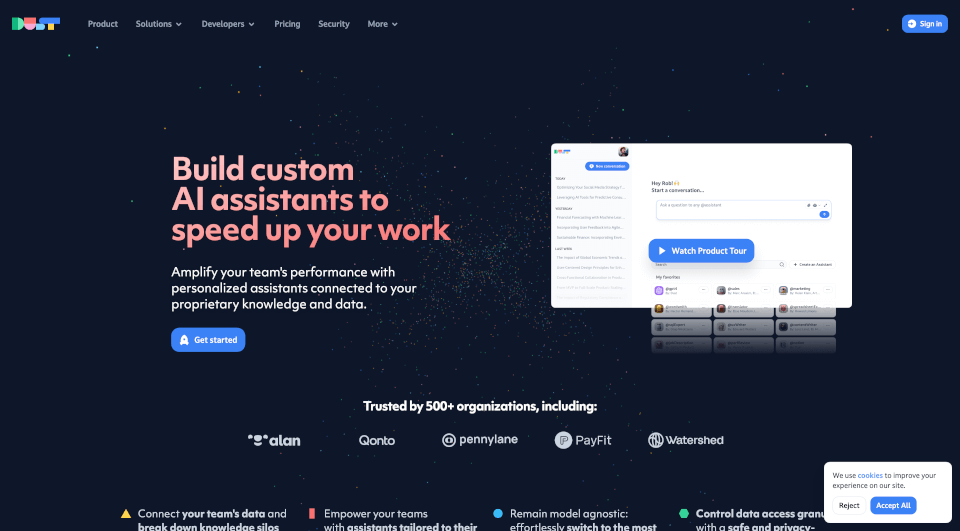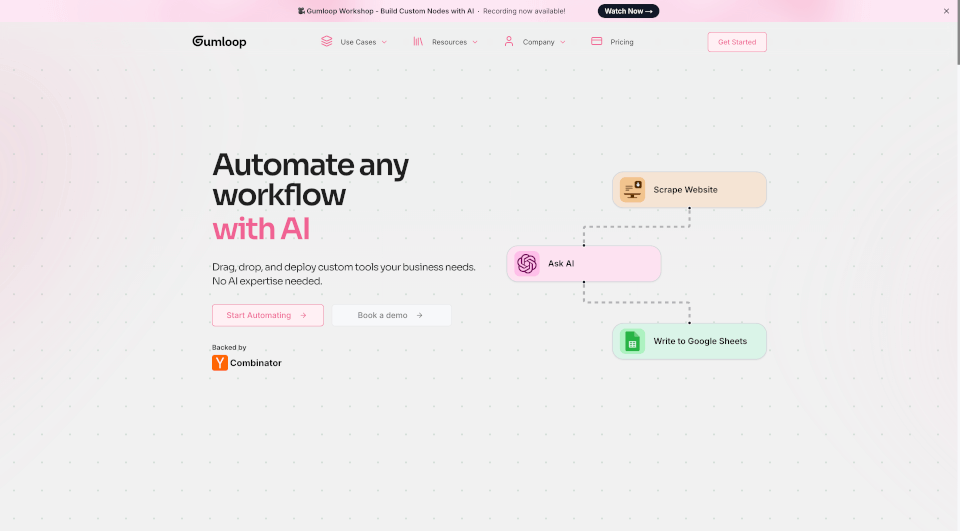What is Dust?
Dust is revolutionizing the way teams work by offering custom AI assistants that enhance productivity and streamline operations. These intelligent assistants are designed to break down knowledge silos and empower organizations by connecting proprietary data with advanced AI technology. Dust allows teams to collaboratively harness their collective intelligence, resulting in improved workflows and heightened efficiency.
What are the features of Dust?
Context-Aware Assistants
Dust’s AI assistants are contextually aware, automatically delivering tailored information and actions that are most relevant to users based on their specific needs and queries. This capability helps teams quickly find answers and resources without navigating through cumbersome data silos.
Model Agnostic Flexibility
One of the standout features of Dust is its model agnosticism. Teams can effortlessly switch between various AI models, including both proprietary and open-source options like OpenAI, Anthropic, Mistral, and Llama. This ensures that organizations can always leverage the most advanced AI technologies without altering their existing workflows.
Granular Data Access Control
Dust prioritizes security and privacy, enabling organizations to control data access with a high degree of granularity. Administrators can manage permissions carefully to ensure sensitive information is only accessible to authorized personnel, making Dust a safe solution for teams that handle proprietary data.
Seamless Integrations
Dust integrates seamlessly with popular platforms like Slack, Notion, and GitHub, allowing teams to incorporate AI functionalities into their existing communication and productivity tools. Moreover, Dust offers an API for custom integrations, enhancing the versatility of its applications.
Template-Driven Development
Dust makes it accessible for anyone on the team to create personalized assistants, utilizing predefined templates for various use cases. This lowers the entry barrier for team members to harness AI capabilities without extensive technical knowledge.
Augmented Workflows
Dust enables teams to rapidly prototype and deploy AI solutions that fit within their current workflows. Whether it's drafting content, managing support inquiries, or enhancing sales processes, Dust acts as a powerful extension of team efforts.
What are the characteristics of Dust?
User-Friendly
Dust is designed with an intuitive user interface, making it easy for non-technical users to build and deploy their AI assistants without requiring extensive training.
Scalable
The platform is scalable, catering to small teams and large organizations alike. Its modular architecture allows teams to expand capabilities as their needs evolve.
Continuous Learning
Dust assistants are constantly updated with the latest AI advancements and improvements, ensuring they remain relevant and effective over time.
Impactful Insights
By utilizing AI to analyze data and identify patterns, Dust provides teams with actionable insights that inform strategic decisions and drive business growth.
What are the use cases of Dust?
Marketing and Content Creation
AI assistants can gather market intelligence, generate content, and analyze customer feedback swiftly. Teams can leverage tools like @contentWriter for quick content drafts and @competitive for monitoring competitor activity.
Customer Support
Enhancing customer satisfaction is achievable with AI-powered assistants that can provide real-time solutions to customer queries. Tools such as @supportExpert and @supportAnalyst can assist support teams in resolving issues more efficiently.
Recruiting and People Management
Dust enhances HR processes by providing AI-driven insights during recruitment and employee onboarding. Assistants like @hiringOps can draft job descriptions while @onboardingBuddy provides guidance to new hires.
Engineering and Development
Engineers can significantly cut down on research and troubleshooting time with assistants like @codeGenius and @engIncidents, which provide resources and support for ongoing projects and incident management.
Knowledge Management
Knowledge retention and sharing become seamless with assistants like @docsNew that can create and update documentation based on team conversations, ensuring that vital information is always up-to-date and accessible.
Sales Enhancement
From prospecting to closing deals, sales teams benefit from assistants like @outboundDraft that help generate personalized outreach messages and @accountSummary that provide insights into customer relationships.
How to use Dust?
- Setup: Begin by integrating Dust into your existing platforms (Slack, Notion, etc.) using the provided API or existing integrations.
- Create Assistants: Utilize templates to create custom assistants tailored to your team's specific workflows and needs.
- Training: Encourage team members to familiarize themselves with the AI capabilities and potential use cases via internal training sessions or documentation.
- Monitor Performance: Regularly assess the performance of AI assistants, gathering feedback from team members to refine their functionalities and ensure they meet evolving demands.
- Update & Iterate: Continuously improve the AI assistants based on new data and AI advancements to keep them relevant and impactful.








